Types of Green Vegetables With Their Name and Picture – Identification Guide

Green vegetables come in all shapes and sizes. Common types of green vegetables are green beans, broccoli, cabbage, and asparagus. There are also plenty of green leafy vegetables like kale, spinach, and lettuce that are incredibly tasty and healthy. There are also green vegetables like peas, cucumbers, and avocado that are actually types of green fruits or legumes.
Green vegetables are low in calories and packed with fiber, minerals, and vitamins. Like all plant life, green fruit and green vegetables contain a green pigment called chlorophyll. This is a vital part of photosynthesis, and the pigment is also good for humans. Additionally, vegetables that are predominantly green are high in folate, lutein, and vitamin K — all necessary for good health.
What are some of the tastiest types of green vegetables to add to your diet? This article contains descriptions of green vegetables, leafy green vegetables, and the types of green fruit we consume like vegetables.
What Vegetables Are Green in Color?
Green vegetables are classified into several categories or families. For example, cabbage, Brussels sprouts, and broccoli are cruciferous vegetables. Celery and asparagus are edible plant stems. Cucumbers and zucchini are classed as marrows, scallions are in the allium family, and spinach, kale, and Swiss chard are leafy greens.
Types of Green Vegetables (With Pictures)
Green vegetables are excellent foods you can include in your diet — raw or cooked. Here is a list of green vegetables, including some of the most common types of greens, as well as some more unusual green vegetables.
Broccoli (Brassica oleracea var. italica)

Broccoli
Broccoli is a green vegetable belonging to the cabbage family Brassicaceae. This edible green plant has a recognizable flowering head, consisting of stalked florets. Broccoli’s large flower head is dark to medium green, and cutting the vegetable reveals a light green to yellowish center. Typically, broccoli grows 18” to 30” (45 – 76 cm) tall.
There are three varieties of broccoli. The most common is green broccoli, called Calabrese broccoli. This is the type you commonly find in the store. However, there is also sprouting broccoli that is typically purple. Then there is purple cauliflower — a kind of broccoli that looks like cauliflower that consists of tiny flower buds.
Cabbage (Brassica oleracea)

Cabbage
Cabbage is a common edible green vegetable related to kale, broccoli, Brussels sprouts, and cauliflower. Green cabbage is the type most used in slaws and cooking. The green vegetable has a large, rounded head consisting of tightly packed yellowish-green to dark green leaves.
Green cabbages range in size from 1lb. to 9 lbs (0.5 – 4 kg). Raw green cabbage has a peppery taste. However, you can also steam, braise, sauté, and ferment the green leaves to make sauerkraut.
Here are two more varieties of cabbages:
Savoy cabbage: A round, green-colored cabbage with crinkled, lacy leaves. Savoy cabbages have a milder taste than traditional green cabbages. They are delicious in salads, braised in butter, or used in stir-fries.
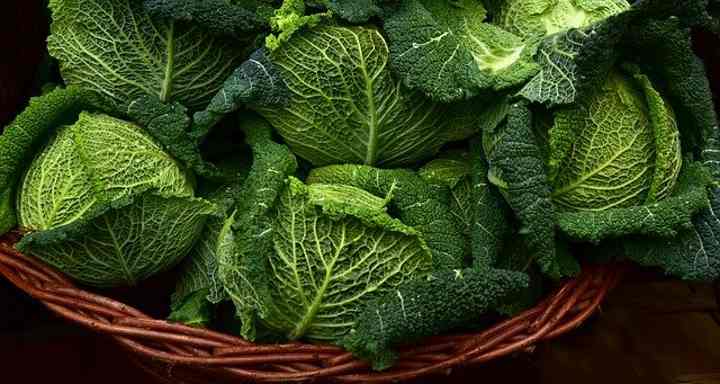
Savoy cabbages
Chinese cabbage: This light green vegetable is also called napa cabbage. The vegetable has a mild flavor with a slightly peppery taste. The cabbage is identified by its light green leaves and thick white stalk.

Chinese cabbage
Brussels Sprouts

Brussels sprouts
A Brussels sprout looks like a miniature cabbage measuring on average 1”(2.5 cm) in diameter. Like cabbage, Brussels sprouts are cruciferous green vegetables in the family Brassicaceae. The small green leafy balls grow on stiff stalks growing 24” to 47” (60 – 120 cm) tall, with many sprouts on a single stem.
Brussels sprouts have a high sulfur content, giving them a pungent taste. The best way to prepare the small round green vegetables for cooking is to roast, grill, or fry them. Like most green cruciferous vegetables, Brussels sprouts are high in fiber, vitamin C, and vitamin K.
Green Beans (Phaseolus vulgaris)

Green beans
Green beans are long, slender green vegetables consumed with their edible pods. The pencil-like vegetable pods measure on average 5” (12.7 cm) long. They are usually cut into smaller sections to use in cooking. Green beans are the unripe fruits of the common bean plant.
A member of the legume family, green beans are also called string beans, French beans, or snap beans. Green beans can be prepared by boiling, stir-frying, steaming, baking, or adding to stews, soups, and casseroles. Apart from green beans, several other green, unripe varieties of peas and beans are used in cooking.
Green Bell Pepper (Capsicum annuum)

Green bell pepper
Green bell pepper is a crunchy green vegetable with a sweet taste. Bell peppers are a type of green berry used as a vegetable. It has a barrel shape with three or four lobes around its base. Green bell peppers usually measure between 2” and 5” (5 to 13 cm) tall.
Bell peppers also go by the names sweet peppers, paprika, or capsicum. Although green bell peppers are classified along with spicy chili peppers, they don’t have a hot, tangy taste. This is because they lack capsaicin — the “hot” chemical that gives chilies the burning sensation when you eat them.
The most common colors of bell peppers are green, red, and yellow.
Green Cauliflower

Green cauliflower
An unusual type of green vegetable is green cauliflower. This type of cauliflower has the characteristics of a standard cauliflower apart from its lime green head or curd. Like white cauliflower, the edible green vegetable has a densely packed head of green florets.
Another unusual green vegetable is the Romanesco cauliflower. The flower head of this vegetable consists of upward-pointing pyramidal florets. This gives the green cauliflower an overall triangular shape and a vibrant yellowish-green color.

Romanesco cauliflower
Leeks (Allium ampeloprasum)

Leeks
Leeks are tall green vegetables that are members of the genus Allium. Leeks have broad, flat green basal leaves growing in sheaths from a white bulb. Leeks typically grow 6” to 10” (15 – 25 cm) tall, and their thick green leaves form a cylinder-like vegetable 2” (5 cm) in diameter.
Leeks look like large green onions with crunchy green leaves. The leaf color starts yellowish-green near the white bulb and gradually becomes darker toward the leaf tips. Compared to onions, leeks have a milder taste. Typically, leeks can be used as mild onions, and you can fry or boil them.
Scallions or Green Onion (Allium cepa)

Scallions / Green onions
Scallions have a small white onion bulb and long green tubular leaves growing directly from the bulb. The tubular leaves grow up to 18” (45 cm) tall and are relatively stiff or soft depending on the variety. Because of their green leaves, scallions are also called green onions.
Also called spring onions, scallions have many uses in world cuisine. For example, chopped green scallions are used in Asian, Chinese, Mexican, and British cooking. You can also eat raw scallions because they have a less intense taste than brown onions.
Cucumber (Cucumis sativus)

Cucumbers
Cucumbers are a type of green pepo — a type of berry. Cucumbers typically have a cylindrical shape with tapered ends. Depending on the variety, the green skin can be smooth or bumpy. Also, cucumbers range in size from 4” to 24” (10 – 61 cm) long and up to 4” (10 cm) in diameter.
This edible green berry is typically prepared as a vegetable and consumed raw or pickled. Cucumbers are known for their fresh, crisp taste and crunchy texture.
Green cucumbers are also classified by their use. Therefore, there are slicing cucumbers — long green vegetables with smooth skin. And pickling cucumbers — shorter, stouter vegetables with bumpy green skin.
Zucchini (Cucurbita)
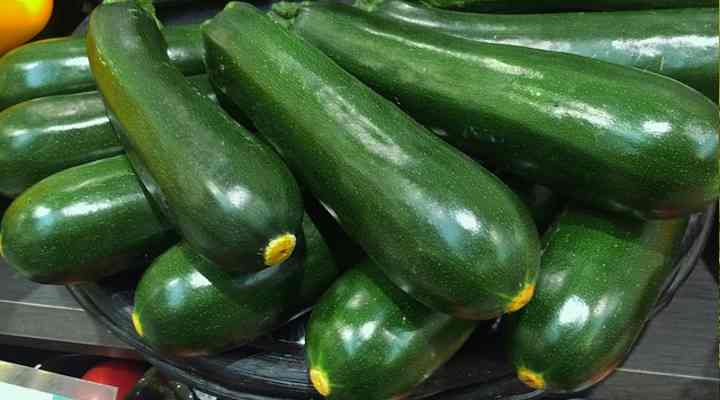
Zucchinis / Courgettes
Zucchini is a green vegetable with a cylindrical shape like a cucumber. Zucchini crops are a type of green berry used as a vegetable. The marrow plant is usually around 6” – 10” (15 – 25 cm) long with a rounded end. Typically, zucchini is cooked before eating.
Most zucchini vegetables are dark green, but some can be striped or have bright yellow skin. Zucchini is related to squash plants, and they are also called courgettes or baby marrows. All the vegetable’s names refer to its small, marrow-like appearance.
Celery (Apium graveolens)
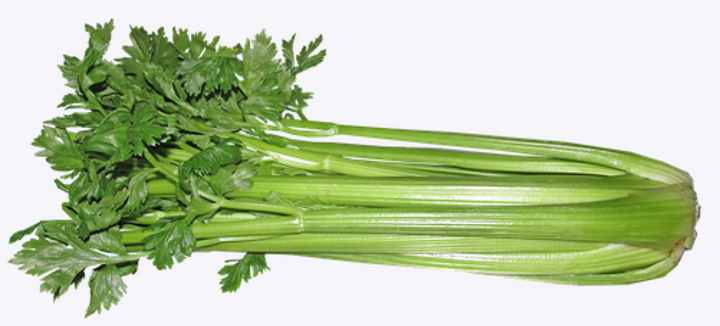
Celery
Celery is a type of green vegetable with edible stems. The erect pale green plant’s fibrous stems are a crescent shape on the cross-section. The curved, convex side has a ribbed, light green appearance, and the inner, concave side is smooth and pale green to white. Celery grows up to 18” (45 cm) tall.
Celery is also identified by its dark green leaves, like parsley leaves. Another feature of celery is its stringy stems.
Celery can be consumed raw when chopped into thin slices and added to salads. Or it can be added to soups, stews, or casseroles.
Globe Artichoke (Cynara cardunculus var. scolymus)

Globe artichokes
The globe artichoke is a perennial vegetable plant that looks like a thistle and grows up to 6 ft. (1.8 m) tall. The edible part of the artichoke is the “heart” in the center of the sizable scaly flower head. When in bloom, the globe artichoke has a purple flower consisting of fine staminal filaments.
Usually, the stiff triangular scales of the large head are removed to reveal the heart. These are the tender leaves at the base of the flower head. However, they become inedible as the plant grows taller and begins to bloom.
Okra (Abelmoschus esculentus)

Okra
Okra is a type of vegetable grown for its tender, edible seed pods. The green vegetables typically grow 2” to 6” (5 – 15 cm) long. The green pods look like large bean pods and have slender, tapered ends. Edible okra pods are known for the mucilaginous texture that naturally thickens gumbos, soups, and stews.
Due to the slender green seed pods, okra is also called “lady’s fingers.” The vegetables can be prepared for consumption by cooking in soups or stews, pickling, or eating raw in salads. Young green okra leaves are also edible and can be prepared like beet greens and added to salads.
Asparagus (Asparagus officinalis)

Asparagus
Asparagus is a perennial flowering vegetable with edible green shoots and leaves. The edible part of the delicious green vegetable usually grows 3.5” (9 cm) long and is up to 0.6” (1.6 cm) in diameter. However, asparagus can grow 40” to 60” (100 – 152 cm) tall.
Standard asparagus looks like small green spears with pointed tips. Depending on the variety, the straight stems with the tapered head can be dark green with purple coloring at the ends. Usually, only young asparagus stems are eaten because the plant becomes woody and stringy as it matures.
Avocado (Persea americana)
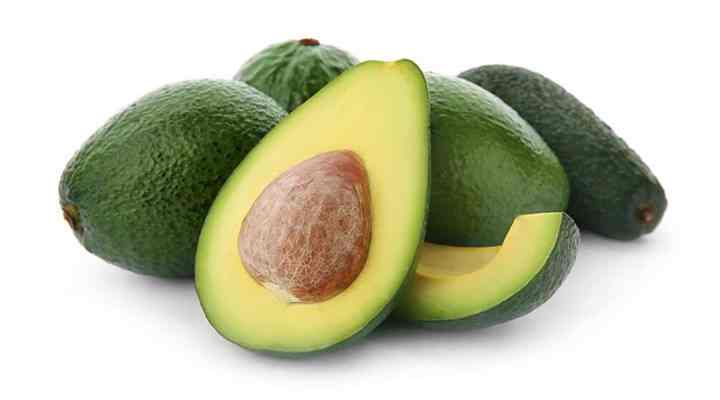
Avocado
Avocado is a green, pear-like vegetable with a dark green to black bumpy skin, buttery green flesh, and a large stone in the center. Botanically, avocado is a large berry used as a savory vegetable. The green berry vegetable can grow between 3” and 8” (7 – 20 cm) long.
Avocado fruits have a distinct smooth texture and subtle flavor. Although you can add avocado to sweet dishes, it is typically consumed in savory dishes. Avocado is a staple of Mexican cuisine, where it is used to make guacamole. In addition, raw avocado is used for making California rolls in sushi.
Fennel (Foeniculum vulgare)

Fennel
Fennel is a vegetable with green leaves and stalks and an aromatic white bulb. The yellow flowers, stalks, green fruits, and feathery green leaves of the fennel plant are used as herbs for their anise or licorice flavor. Fennel plants grow up to 8 ft. (2.5 m) tall.
All parts of the fennel plant are used in various cuisines. The fruit is dried and used as an aniseed-like spice. The green leaves look like dill and are useful as an aromatic garnish. The white bulb has a crispy texture and can be used grilled, stewed, braised, or sautéed.
Green Peas (Pisum sativum)

Green peas
Green peas belong to the legume family, and they are usually sold as a vegetable. Like all legumes, green peas grow in a long seed pod containing several round fruits or peas. The annual vegetables grow on vines and can reach up to 7 ft. (2.1 m) tall.
When cooked as a vegetable, green peas have a distinctly sweet taste. Fresh or frozen green peas are typically boiled in water and flavored with butter as a side dish. The small round peas can also be added to casseroles, soups, or stews. Green or yellow peas are also dried and used to make soups.
Types of Green Leafy Vegetables
Leafy greens are popular vegetables for their taste, and because they’re packed with nutrients and vitamins. There are many types of leafy green vegetables available, here are just a few of the most popular.
Kale
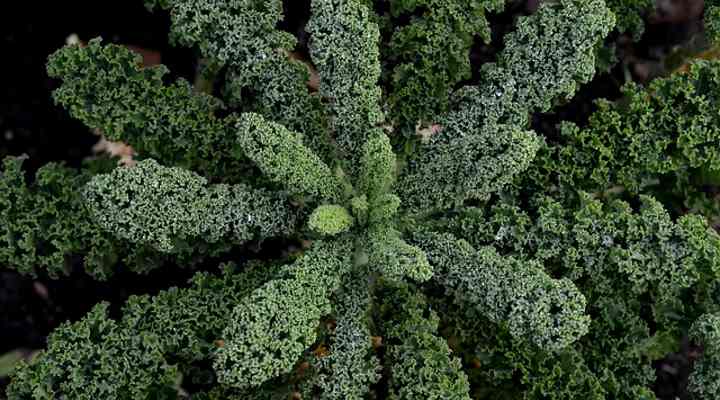
Kale
Kale is a green leafy cabbage with large crinkly leaves and a peppery taste. Unlike cabbage, kale doesn’t form a head, but has large green leaves growing in a rosette shape. Varieties of kale are classified by the leaf shape — curly leaf, bumpy-leaf, plain-leaf, and spear kale.
Because of its hardiness in freezing weather, kale is an ideal winter vegetable for growing in your garden.
Spinach (Spinacia oleracea)

Spinach
Spinach is a popular leafy green vegetable with dark green, ovate leaves growing up to 12” (30 cm) long. The standard way to prepare spinach leaves is by steaming them to reduce oxalate levels. Like many leafy greens, spinach is high in vitamin K.
Microgreens

Microgreens
Microgreens are the immature cotyledon leaves of edible vegetables. The tiny, tender shoots usually have an intense flavor and add a tasty green garnish to many dishes. Microgreens can be grown from many types of vegetables, including carrots, broccoli, herbs, beets, and cabbage.
Lettuce (Lactuca sativa)

Lettuces
Lettuce is an annual leafy green vegetable that is used fresh in salads. There are many types of lettuce, each with its own characteristics, taste, texture, and appearance.
Bok Choy (Brassica rapa)

Bok choy
Bok choy or pak choi is a type of cabbage popular in Asian cuisine. This green leafy vegetable has green leaves growing from a bulbous base. Usually, the plant is used as a vegetable in stir-fries.
Swiss Chard (Beta vulgaris)

Swiss chard
Swiss chard is a green leafy vegetable with brightly colored red stalks. The nutritious green ribbed leaves can be used raw in salads or chopped up and added to stir-fries, boiled, or sautéed. The bitter taste of Swiss chard leaves diminishes with cooking.
Watercress

watercress
Watercress is a small leafy green vegetable with round dark green leaves that have a spicy flavor. Watercress grows as a semi-aquatic cruciferous vegetable and is related to radish, mustard, and wasabi.
Related articles:
